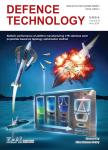Ballistic impact response of flexible and rigid UHMWPE textile composites:Experiments and simulations
作者机构:School of Engineering and Information TechnologyThe University of New South WalesCanberraACT2600Australia
出 版 物:《Defence Technology(防务技术)》 (Defence Technology)
年 卷 期:2023年第22卷第4期
页 面:37-53页
核心收录:
学科分类:08[工学] 0826[工学-兵器科学与技术] 082603[工学-火炮、自动武器与弹药工程]
基 金:The authors appreciate the contribution to this work by Dr Krishna Shankar who was retired during the writing of the paper. The authors acknowledge the Impact Dynamics Laboratory at UNSW Canberra for providing the experimental services described in this paper
主 题:Impact behaviour Textile composite UHMWPE fibre Energy absorption Finite element analysis
摘 要:This study elaborates on the effects of matrix rigidity on the high-velocity impact behaviour of UHMWPE textile composites using experimental and numerical *** composite samples were manufactured of a plain-weave fabric(comprising Spectra?1000 fibres)and four different matrix ***-velocity impact tests were conducted by launching a spherical steel projectile to strike on the prepared samples via a gas *** experimental results showed that the textile composites gradually changed from a membrane stretching mode to a plate bending mode as the matrix rigidity and thickness *** composites deformed in the membrane stretching mode had higher impact resistance and energy absorption capacity,and it was found that the average energy absorption per ply was much higher in this mode,although the number of broken yarns was smaller in the perforated ***,the flexible matrix composites always had higher perforation resistance but larger deformation than the rigid matrix counterparts in the tested thickness and velocity range.A novel numerical modelling approach with enhanced computational efficiency was proposed to simulate textile composites in mesoscale *** simulation results revealed that stress and strain development in the more rigid matrix composite was localised in the vicinity of the impact location,leading to larger local deformation and inferior perforation resistance.



